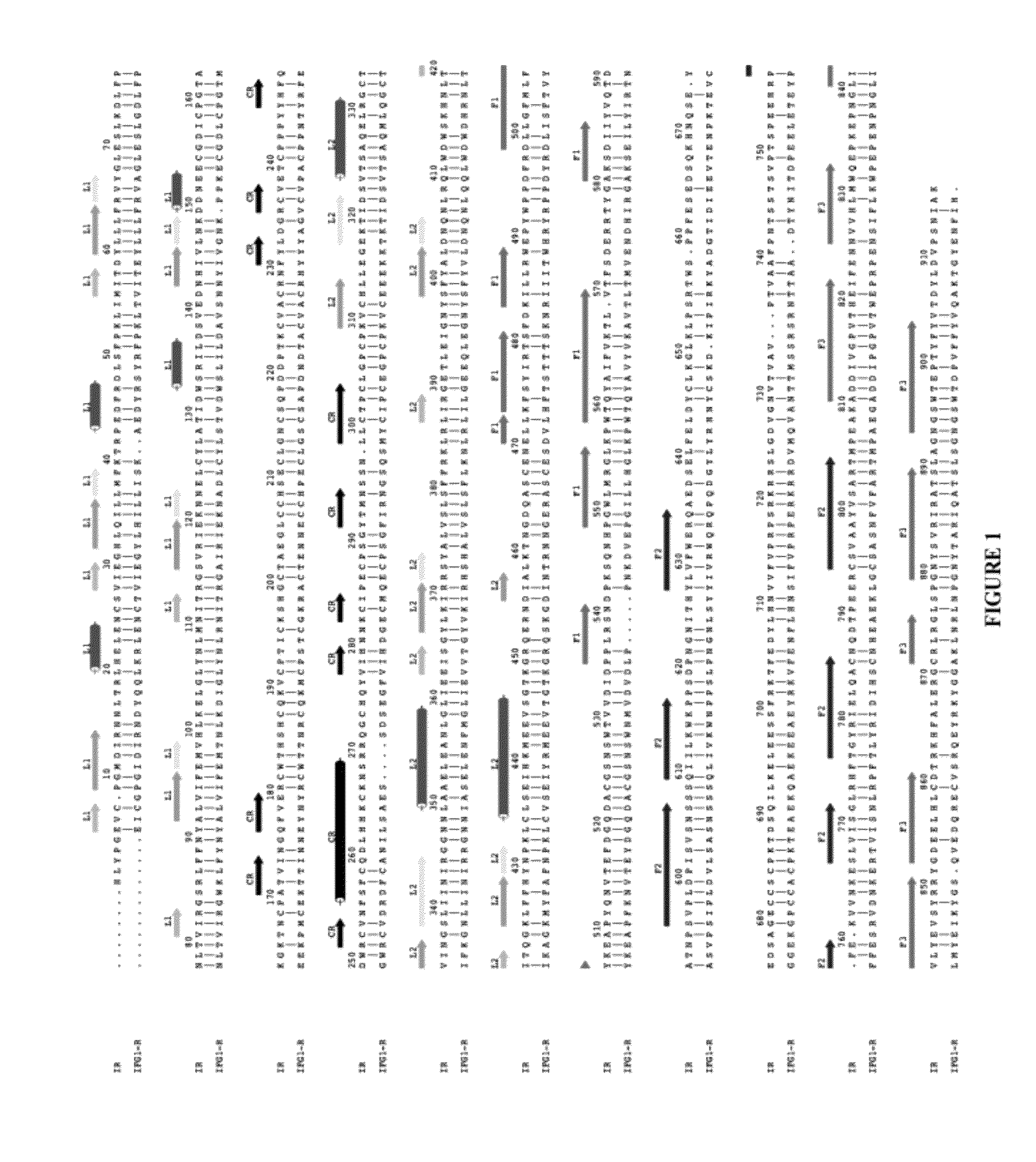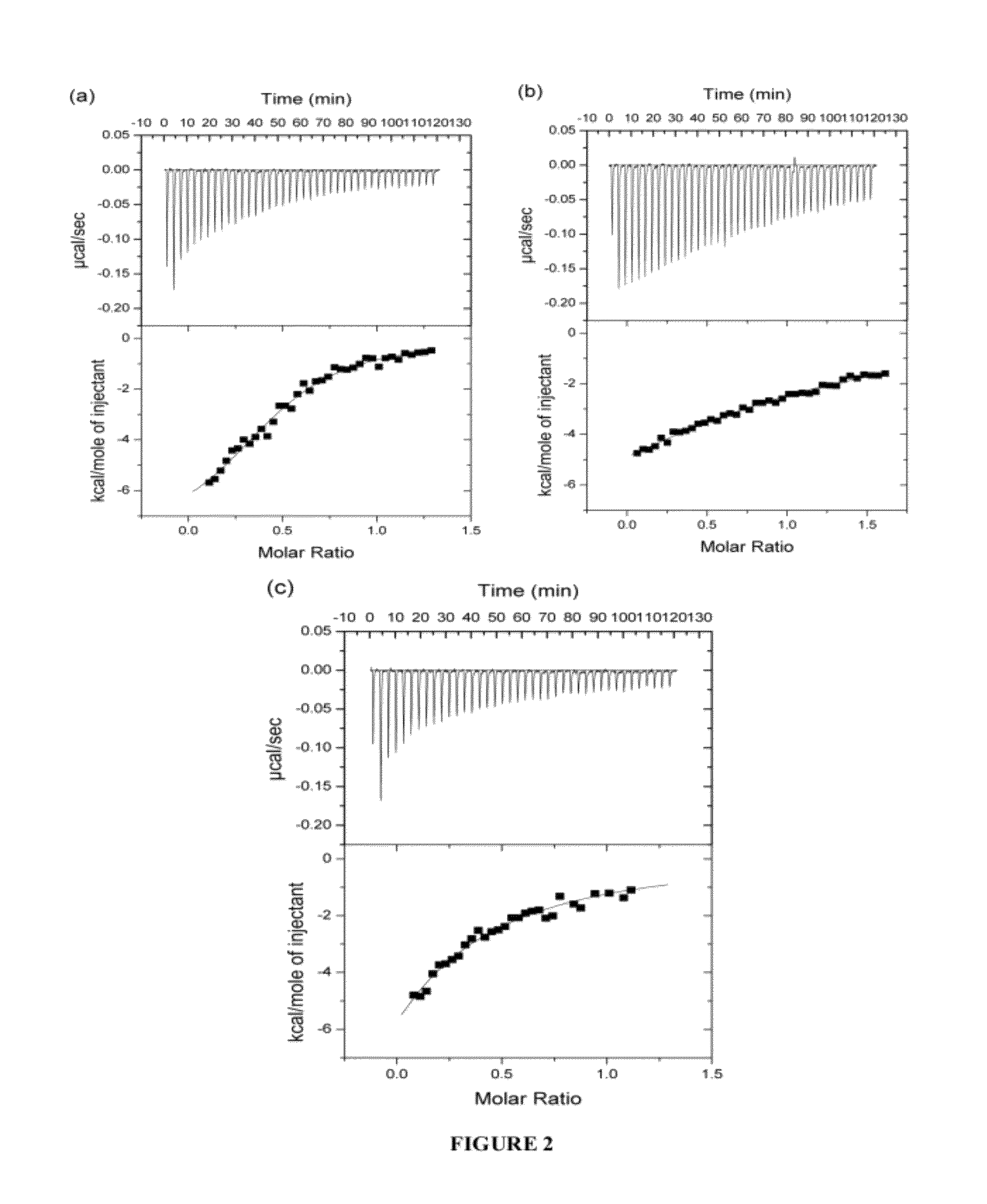Structure of the C-terminal region of the insulin receptor α-chain and of the insulin-like growth factor receptor α-chain
a technology of c-terminal region and insulin receptor, which is applied in the direction of instruments, molecular structures, metabolism disorders, etc., can solve the problems of infertility, impaired postnatal growth, and embryonic growth deficiency, and the conclusions of these studies have been questioned
- Summary
- Abstract
- Description
- Claims
- Application Information
AI Technical Summary
Benefits of technology
Problems solved by technology
Method used
Image
Examples
example 1
A Thermodynamic Study of Ligand Binding to the First Three Domains of the Human Insulin Receptor (IR): Relationship Between the IR α-Chain C-Terminal Peptide (αCT) and the Site 1 Insulin Mimetic Peptides
1.1 Introduction
[0322]In order to study ligand binding to the first three domains of IR ectodomain, isothermal titration calorimetry (ITC) was used. ITC allowed a direct assay of the interactions between the IR ectodomain classical αCT peptide (residues 704-719; SEQ ID NO: 11) and IR485 (a construct consisting of the first three N-terminal domains of the IR; SEQ ID NO: 10), as well as the interaction between the analogous peptide of human IGF-1R and IR485. At the same time the thermodynamics of binding of the N- and C-terminal segments of the insulin mimetic peptide S519 (Schäffer et al., 2003) to IR485, as well as the binding of S519 itself to IR485 were examined. S519 (SLEEEWAQVECEVYGRGCPSGSLDESFYDWFERQLG; SEQ ID NO: 16) is a 36-residue peptide resulting from the affinity-optimizat...
example 2
Solving the Crystal Structure of the C-Terminal Region of the α-Chain of IR
2.1 Introduction: Ambiguous Electron Density
[0334]As described previously (WO 07 / 147,213), an area of strand-like ambiguous electron density was present near the L1-β2 face of IR. However, despite numerous different processing and refinement protocols, the density was impossible to interpret in terms of any peptide sequence. The data described in Example 1 above implied a surprising and previously unexpected sequence relationship between the S519C16 peptide (SEQ ID NO: 18) and the ‘classical’αCT peptide region (residues 704-719; SEQ ID NO: 11) described previously in the literature (Kurose et al., 1994). X-ray data obtained in WO 07 / 147,213 were revisited and further reviewed with the possibility then in mind that the ambiguous electron density near the L1-β2 face of IR could have been due to the ‘classical’αCT peptide region of the IR α-chain.
2.2 Protein Production, Crystallisation and Data Collection from I...
example 3
3.1 Introduction
[0343]There is a high level of sequence identity between, on the one hand, the L1 domains of IGF-1R and IR, and, on the other hand, between the C-terminal regions of the α-chain of IGF-1R and IR (FIG. 1 and FIG. 6c). Accordingly, models of IR in complex with S519C16 and the IGF-1R α-chain residues 681-697, respectively, were constructed using the MODELLER program (Sali and Blundell, 1993) with the crystallographic structure of IR ectodomain presented in the main text as a template. Models of the ectodomain of IGF-1R in complex, respectively, with the IGF-1R α-chain residues 681-697 (SEQ ID NO: 15), S519C16 (SEQ ID NO: 18) and the IR α-chain residues 693-710 (SEQ ID NO: 13) were constructed employing the crystal structure of the first three domains of IGF-1R (Garrett et al., 1998), the structure of the IR ectodomain presented here and the known sequence relationship between IR and IGF-1R (Adams et al., 2000).
3.2 Materials and Methods for Modelling
[0...
PUM
| Property | Measurement | Unit |
|---|---|---|
| molar ratio | aaaaa | aaaaa |
| molar ratio | aaaaa | aaaaa |
| molar ratio | aaaaa | aaaaa |
Abstract
Description
Claims
Application Information
 Login to View More
Login to View More - R&D
- Intellectual Property
- Life Sciences
- Materials
- Tech Scout
- Unparalleled Data Quality
- Higher Quality Content
- 60% Fewer Hallucinations
Browse by: Latest US Patents, China's latest patents, Technical Efficacy Thesaurus, Application Domain, Technology Topic, Popular Technical Reports.
© 2025 PatSnap. All rights reserved.Legal|Privacy policy|Modern Slavery Act Transparency Statement|Sitemap|About US| Contact US: help@patsnap.com



